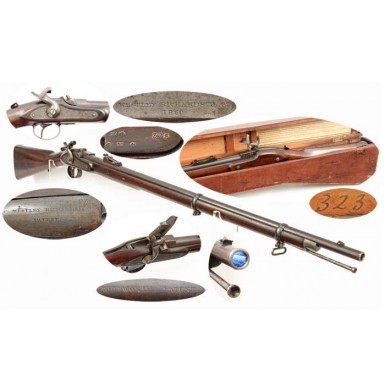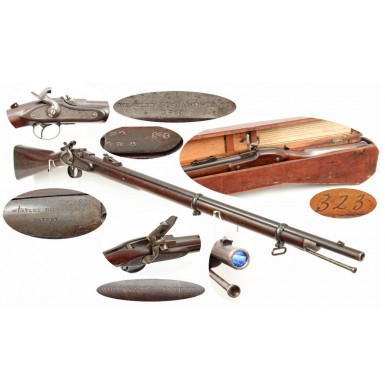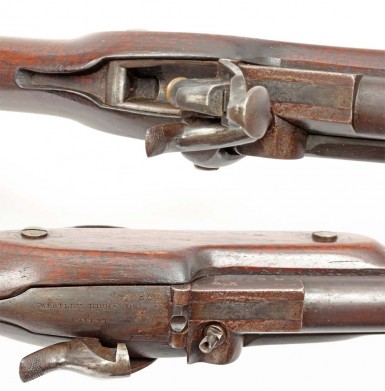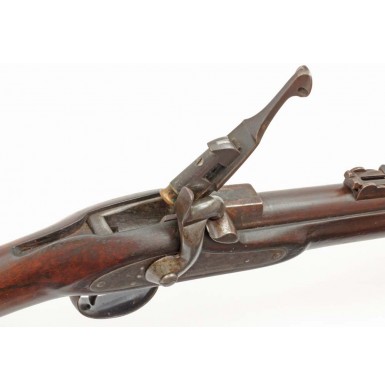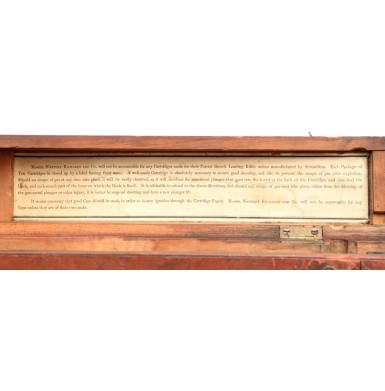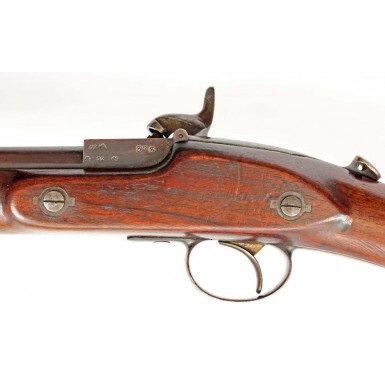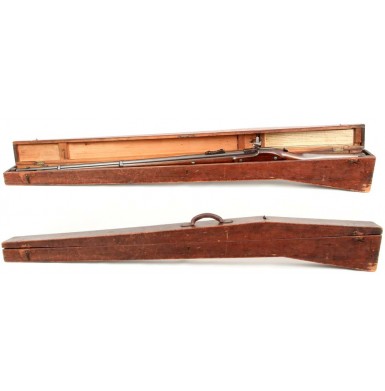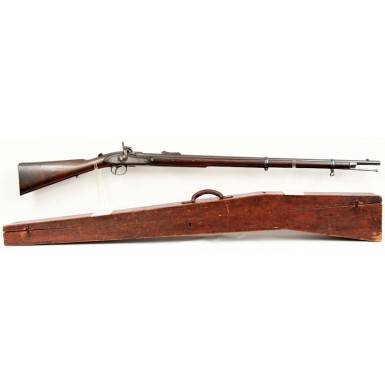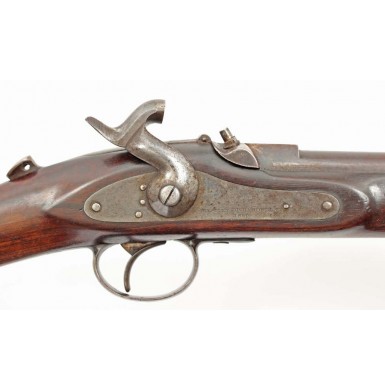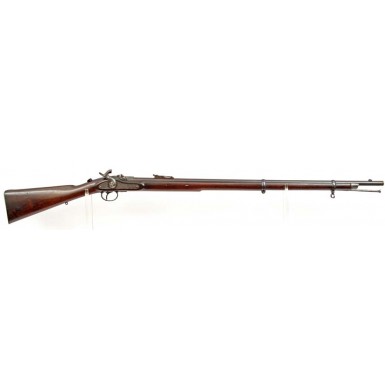Exceptional Westley Richards Monkey Tail Military Match Rifle
- Product Code: FLA-2136-SOLD
- Availability: Out Of Stock
-
$1.00
Very few names in English gunmaking are associated with the level of quality, craftsmanship and innovation as that of Westley Richards. The firm was established by Westley Richards’ father, William Westley Richards, in Birmingham in 1812. Westley Richards was born in 1814 and joined the family business in 1840, making it “Westley Richards & Co”. Some time in 1859 or 1860 the “& Co” was officially dropped from the name until 1873, a year after Richards’ retirement, when the business became Westley Richards & Co LTD, which remains in business to this day as a manufacturer of high grade sporting arms. During the lifetimes of the two Richards, they received numerous English patents for firearms designs. Author and firearms researcher DeWitt Bailey may have said it best of Westley Richards when he noted: “The Westley Richards firm certainly enjoyed the highest reputation of any Birmingham maker with the “sporting gentry”, and were the only Birmingham manufacturers to seriously compete with the “Best London” makers in the field of sporting guns and rifles.” In addition to their 82 High Street manufacturing location in Birmingham, the Richards maintained a London retail location at 170 New Bond Street from 1815 through 1871, to better serve their upper class clientele. Among the numerous patents that Westley Richards held, his #633 (March 25, 1858) for a breech loading percussion rifle design, was probably the most important. This patent covered his famous “Monkey-Tail” breechloading system. This simple and elegant design allowed the advantages of a breechloading rifle to be applied to traditional muzzle loading, cap lock designs. The system received its nickname from the shape of the breech lever, which resembled a monkey’s tail when the breech was opened for loading. The locking system utilized a sliding plunger that was actuated by the pressure of the cartridge being fired, moving backwards and locking the breech so it could not open until the pressure subsided. As a double safety, the hammer was machined in such a way that the breech could only be opened when the hammer nose was resting on the cone (nipple). Placing the gun on half-cock or full-cock prevented the action from being opened unintentionally. Richards was also innovative in advancing the science of rifling, and appears to have developed the concept of polygonal rifling simultaneously with (or possibly just prior to) Joseph Whitworth. As Whitworth had no facilities to manufacture arms during his early days (prior to the establishment of the Whitworth Rifle Company), he relied upon Richards to produce his early guns. As such it comes as no surprise that both men should experiment with polygonal rifling at the same time. While Whitworth’s approach utilized a hexagonal bore (6-sided) with a tightly fit hexagonal bullet, the Richards design used a slightly undersized projectile that “auto centered” it the octagonal (8-sided) bore when fired. The Whitworth system of rifling had hard angels and 6 crisp sides, while the Richards rifling was contoured with 8 deep beveled grooves that were much deeper (by about 3/10 of an inch) than the actual bore diameter. While the Whitworth guns were true 52-Bore (.451 caliber), the Richards variant was 52-Bore (.451”) with grooves that averaged around .480”, and relied on the previously mentioned “auto centering” theory rather than the Whitworth’s tight mechanical fit. Both rifling systems utilized the relatively fast 1:20” rate of twist, nearly twice as fast as most elongated ball rifling designs of the day. Interestingly, Richards never patented his rifling system, although Whitworth certainly patented his. Most of the Westley Richards guns manufactured with his octagonal rifling were marked “Whitworth’s Patent” on the barrel, even though the design concept was not covered by Whitworth’s patent, nor was Whitworth due any royalties. The marking might well have been as much a marketing scheme to capitalize on the reputation for accuracy of Whitworth’s rifling as a “tip of the hat” to Richards’ friend and early manufacturing client. The accuracy of Richards rifles was quickly established by their performance at the NRA matches held at Woolwich. From 1860 through the mid-1880s, the Westley Richards “Monkey Tail” match rifles with 36” or 39” barrels always lead the pack for accuracy in the breechloading rifle competitions. Like most English gunsmiths, Richards hope most fervently to obtain a major contract from the War Department for one of his designs. His “monkey tail” system eventually earned him the desired contract, but for primarily for cavalry carbines, and not rifles. Although the Westley Richards system was tested by the Small Arms Committee several times (starting in 1859 and continuing through the mid-1860’s), it was not until 1866 that a major order from the military was forthcoming. One specific advantage to his design noted by the committee was that the Westley Richards breechloader with its unique rifling could utilize a projectile that was hardened, instead of the soft lead needed to use in a muzzle loader that relied upon the expansion of the bullet to achieve a tight mechanical fit on firing. The hardened projectile allowed the bullet to achieve much greater penetration than its soft lead competitor. The Westley Richards design tested well enough for an initial order of 100 39” breechloading military rifles to be placed by the War Department for further field evaluations in 1860, but no further orders were placed until the following year. In April of 1861 2,000 of the carbines with 19” barrels were ordered for field trials by the 10th & 18th Hussars, and the 6th Dragoon Guards. Unfortunately, the guns were made under four different “sealed patterns’ and ended up being delivered with at least three different rear sight graduations (400, 700 & 800 yards) and two different chamber dimensions! After working through the issues in the field and determining that a slightly tighter bore size of about .448” was appropriate, the Richards achieved his goal and allowed the Royal Small Arms Factory (RSAF, better known simply as “Enfield”) to produced 20,000 of his “monkey tail” carbines with 20” barrels, under license. In the end 19,000 were produced and these very accurate, percussion breech loading carbines saw major use among British Yeomanry cavalry units, as well as with colonial cavalry in Australia and South Africa. The popularity of the system in South Africa resulted in some 18,000 or so additional carbines with 25” barrels being exported to that country between 1872 and 1885. There they saw significant service in both Boer Wars and were highly prized for their long-range effectiveness and accuracy against more modern rifle designs using self-contained metallic ammunition. In South Africa, in particular, the Westley Richards carbines saw heavy use until the beginning of the 20th century. The only other British military breechloading rifle order Richards obtained was in 1864 for 2,000 36” military rifles with bayonets for use by the Montreal Garrison during the Fenian Uprising in Canada. In all Richards appears to have manufactured (or licensed the manufacturing of) about 61,000 “Monkey Tails’ of all varieties. Of those, 19,000 were manufactured at Enfield, leaving Richards to produce about 42,000. Another 11,500 of the guns were produced on contract for Portugal, in rifle, various carbine and even pistol variations. The most prized of the Westley Richards “Monkey Tails’ were his Military Match and Prize Rifles. Richards produced 1,500 of these extremely well made and accurate rifles between 1858 and 1869. They were manufactured with both 36” and 39” barrels, with the 39” gun being produced in very limited quantities. These “Match & Prize Rifles’ were the guns that consistently won the breechloading rifle competitions at Woolwich from their inception until the 1886 rule change that required breechloading rifles to utilized “fixed” or internally primed ammunition, which eliminated the percussion guns from completion. Of these highly prized and desirable guns (numbered individually from 1 to 1500), less than 50 are known to have survived to today. Most of the above research regarding the “monkey tail” (and especially the production figures) is derived from the work of Robbie Betteridge, from a paper he delivered to Great Britain’s Historical Breechloading Smallarms Association.
Offered here is one of the very scarce and very high condition examples of a Westley Richards Monkey-Tail Breechloading Match & Prize Rifle. The gun is in about VERY FINE+ to NEAR EXCELLENT condition and even retains its original wooden case, which is numbered to the gun on the interior. The lock of the rifle is clearly marked in to lines: WESTELY RICHARDS & Co / 1860. The top of the “monkey tail” is engraved WESTELY RICHARDS / PATENT and is also marked with the serial number 323. This same number appears on the plunger inside the breech lever, on the left side of the breech and inside the wooden case that accompanies the gun. The left side of the breech is marked with the aforementioned serial number, the three Birmingham commercial View, Proof and Definitive Proof marks and a pair of 52 bore gauge marks, indicating the gun is .451 caliber. The top of the barrel is engraved, just forward of the rear sight, WHITWORTH PATENT. The rifle is in a military-style musket configuration, and the 36” barrel is secured to the stock with a single transverse wedge where the rear barrel band would normally be located, and with a pair of Palmer patent barrel bands in the traditional middle and upper locations. The gun is stocked to within 3 ““ of the muzzle and has an iron forend cap. The rifle is 52” in overall length, and is entirely iron mounted, with the additional decoration of an oval German silver presentation plaque in the reverse buttstock that measures 3 1/8” on the major axis and 2” on the minor axis. The plate does not bear an inscription. The rifle has the typical Westley Richards octagonal rifling, with a .451” land to land diameter and a groove depth of .480”. The rear sight is a precision machined long-base ladder sight, similar to that found on the P-1853 Enfield, with the graduations on the reverse (under) side of the ladder, and the base reversed from the usual Enfield configuration. The reversed base is often encountered on other precision English target rifles of the period, such as those produced by Whitworth and Kerr. The front sight is also precision machined, with a fine blade and extended wings, that appear to be drift adjustable for windage, dovetail mounted onto the sight base. The rifle remains crisp and sharp throughout, and although it shows use, it was clearly always well cared for. The barrel retains about 70%+ of its original deep rust blued finish, with some fading and wear, and some scattered, lightly freckled oxidation present on the surface. The areas where the finish shows wear or fading has developed a smooth plum-brown patina that has blended seamlessly with the original blue and is very attractive. The lock retains about 50%+ of its mottled case coloring, with some oxidized brownish freckling as well. The hammer retains about 20% of its case coloring, and shows some minor surface oxidation, while the hammer itself is fading to the “silvered out” coloration so typical of 19th century English case coloring as it ages and wears. The breech lever retains about 60% of its blued finish, with some fading and wear, which has mixed with the same plum brown patina found on the barrel. The breech shows some lightly scattered pinpricking and minor surface oxidation around the cone seat and breechblock. The original precision cone (nipple) is present, complete with its platinum liner and base. Unfortunately, the gun was dry fired at some point in time and one quarter of the upper edge of the cone has been chipped away. This is the only real damage noted to this fine gun. Were someone to want to fire this precision rifle, the cone would have to be replaced for safety. However, the chip is located on the non-display side, so it does not materially affect the appearance of this gorgeous rifle. The barrel bands and triggerguard both retain about 80% of their deep, dark blued finish. Both barrel bands retain their original screw keepers at their ends. The upper band also retains its original military style sling swivel. A civilian style, sling ring is screwed into the toe of the stock, behind the triggerguard. The buttplate retains about 10%-20% of its blued finish, and is mixed with a grayish brown, lightly oxidized patina. The butt trap compartment in the butt plate opens easily and reveals both of the original cleaning accessories; the original brass cleaning jag that screws onto the cleaning rod, and a chamber cleaning tool. These items are in very nice condition and are rarely found with a Westley Richards rifle these days. The original cleaning rod / ramrod is in place under the barrel in the stock channel. The rod is full length and retains good threads at the end. It has a small, recessed tulip shaped head and swelled shank which secures it against a notch in the forend cap. The style is similar to a Type I P-1853 swelled rod with the first style head. The gun is in mechanically EXCELLENT condition and functions perfectly in every way. All of the screws are original and in fine, crisp condition as well. The “monkey-tail” opens and closes smoothly and the breech-locking plunger (which is often damaged) moves freely. The hammer crisply locks into both half-cock and full cock positions, and the trigger release is crisp and clean, as one would expect from a military match rifle. The bore of the rifle rates about VERY FINE+ to NEAR EXCELLENT it is bright and sharp with crisp Richards style octagonal rifling. The bore shows only some lightly accumulated dirt and grit (which should clean easily) and some very lightly scattered pitting deep in the extended grooves. There is no doubt that with the correct ammunition, this rifle would still be a tack driver. The appropriateness of the ammunition is an interesting subject, as the accompanying wooden case for the rifle retains its original label regarding that subject inside the lid. The label reads:
Messrs. Westley Richards and Co. will not be accountable for any Cartridges made for their Patent Beech Loading Rifles unless manufactured by themselves. Each package of Ten Cartridges is closed up by a label having their name. A well-made Cartridge is absolutely necessary to secure good shooting, and also to prevent the escape of gas after explosion. Should an escape of gas at any time take place, it will be easily observed, as it will discolor the gun-metal plunger that goes into the barrel at the back of the Cartridge, and also foul the block and underneath part of the lever on which the block is fixed. It is advisable to attend to the above directions, and should any escape of gas ever take place, either from the blowing of the gun-metal plunger or other injury, it is better to suspend shooting and have a new plunger fit. It is also necessary that good Caps should be used, in order to insure ignition through the Cartridge Paper. Messrs. Westley Richards & Co. will not be answerable for any Caps unless they are of their own make.
The stock of the rifle is also in VERY FINE to NEAR EXCELLENT condition. The stock is free of any breaks or repairs, and is full length and solid. There is a barely noticeable surface grain crack (which may really only be some raised grain) running diagonally along the grain between the two lock screws on the flat opposite the lock. This is the only defect, however, minor worth noting. Otherwise, the stock shows only the normal bumps and dings from handling and use that one would expect from a competition grade target rifle that actually saw some use. Honestly, the majority of the bumps and dings probably came from storage in the less than form fitted wooden case that accompanies the rifle. The stock appears to retain the majority of its original finish and is in lovely condition.
The rifle is accompanied by its original wooden case, which as previously noted is numbered 323 on the inside of the lid, mating it to the gun. As also mentioned, the original Westley Richards disclaimer regarding the use of proper ammunition is also present inside the lid. The case is in about VERY GOOD, as used condition. The case retains about 70% of its original paint that apparently was more of an orange color when new, but has oxidized to a darker brown color with orange tones. The original color is visible if the leather carrying handle is removed. The leather of the handle has been restored, as the original leather had rotted away. However, the original twisted horsehair former is retained inside the replaced leather, and the original screws secure the handle to the case. The case shows numerous bumps, dings and nicks, as would be expected and some minor chipping to all of the edges and corners. The original hinges are in place, as are the two closure hooks and their accompanying eyes. The original lock is present in the case, but the key is long gone. There is some minor cracking present on the top of the lid, around the cut out for the hammer spur, but this does not appear to have any significant structural ramifications. The rifle fits the case nicely, but I would certainly not recommend transporting or storing the rifle in the case, as it would likely end up dinging up the stock further.
Overall this is simply a wonderful example of a very scarce Westley Richards Monkey Tail Military Match & Prize Rifle, complete with its original wooden case. The gun is 100% complete, correct and original and simply a gorgeous rifle. It would be a wonderful addition to any advanced collection of English arms, especially one that focuses on percussion target and/or percussion breechloaders. This is a rifle that you will be very proud to own and display. For the more adventurous black powder collectors and shooters out there, this a rifle that will probably win you a trophy or two, should you choose to shoot it in competition! With less than 50 of these fine arms known to have survived, this is rare opportunity to add a top notch English polygon-bore military target rifle to your collection, without having to pay the 5-figure plus price for a Whitworth!
Please note, due to the fact that this gun comes with a large, somewhat fragile wooden case, extra shipping costs will apply. Due to the condition and value of the gun, i would recommend picking the gun & its case up at a show I attend in your area.
SOLDTags: Exceptional, Westley, Richards, Monkey, Tail, Military, Match, Rifle

